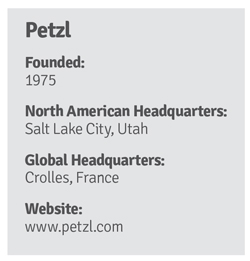The skill — and nerve — it takes to rappel down a wind-turbine blade suspended hundreds of feet above the ground is no doubt impressive. But what about the actual equipment that technicians depend on to keep them safely suspended high above the Earth?
Petzl has been making equipment to keep those who work in high, difficult-to-access places safe and secure. Petzl ropes, lanyards, and other safety equipment have been used for spelunking, mountain climbing, and rescue operations for decades, so it seemed a perfectly symbiotic fit for Petzl’s products to make their way into the wind industry.

Moving into wind
“It was a fit because the industry could see rope access technicians working on buildings and oil platforms,” said Michel Goulet, Professional Division sales manager for Petzl. “So, obviously, you need special skills to do that, and you also need special skills to walk out along a wind turbine and descend down onto the blades.”
Although wind is an industry that Petzl concentrates on, it is safe to say that the company considers itself an integral part of the rope access world, according to Goulet.
“In terms of markets that we serve, rope access is at our core,” he said. “In the rope access industry, as it pertains to wind, those are the workers required to access blades for maintenance and repair.”
Not just anyone is allowed to do that. Technicians have to be properly trained and certified by either the Society of Professional Rope Access Technicians (SPRAT) or the Industrial Rope Access Trade Association (IRATA), according to Goulet.

“Those are some of the training bodies that ensure these individuals have the specialized training and experience to safely rig the proper ropes and descend the blades of the turbine for inspection and repair work,” he said. “But rope access technicians don’t only do that.”
Other industries
Petzl works with a variety of industries, but the common denominator is working at height.
“They’re either accessing some hard-to-reach areas with our products or they’re using our equipment for rescue purposes,” Goulet said. “They may be evacuating a big Ferris wheel, or they may be window cleaners on the side of buildings. These jobs include fall protection, rope access, rope rescue, and anyone working in dark environments.”
Dangling from a blade or working in a turbine nacelle can become quite tedious since they are confined spaces, according to Goulet.

“There are other people on wind turbines who use our equipment, but they’re less technical perhaps than rope access technicians, but all would be trained in fall protection,” he said. “Those are the people who use our equipment and stay inside the column or the nacelle. Those are the lubricators or the electrical technicians who have to do internal servicing. If they must get outside on the top of the nacelle, we have the proper lanyards that they can use to connect to the security rails.”
Normally, there are rails on either side of a nacelle, and Petzl’s Y lanyards connect to both, according to Goulet. Technicians are trained in both rope access and self-rescue or partner rescue in case they cannot climb the tower and must be lowered in the column along the ladderway.
“We don’t make ladder safety systems, but we do make harnesses that are appropriate to connect to existing systems, and we have Y lanyards for 100 percent connectivity when on the top of the nacelle,” he said. “And of course, our headlamps are great to use in that environment as well.”

Headlamps and helmets
Those headlamps can be part of a helmet that Goulet said has some important safety and comfort features.
“Our helmets are great too, because, obviously they’re working with electrical systems,” he said. “Our helmets are fully adaptable to use with full face shields to protect from electrical shorts. And our helmets are ANSI certified, not only for impact but also for electrical protection and compatible with all frequently used hearing protection.”
But when it comes to being protected from accidental falls, it is Petzl’s collection of lanyards and harnesses that are the company’s bread-and-butter items, according to Goulet.
“Petzl makes a wide range of harnesses,” he said. “We have fall arrest harnesses and shock absorbing lanyard systems for more passive protection, as well as specialty rope access harnesses for long hours working in suspension and sitting on an integrated work seat for comfort. If you’re hanging in your harness for hours of blade repair work, your legs go numb if you don’t have a working podium. Comfort equals work efficiency.”

Hands-free work
Another popular item is the Grillon positioning lanyard, according to Goulet.
“The Grillon connects from side D ring to side D ring on the harness, allowing for easy adjustment and hands-free work, such as when a worker needs both hands free when repairing a blade or running cable up to the nacelle,” he said. “We frequently see workers use it when descending a blade to avoid getting blown off center in strong winds.”
OSHA requires all workers who are suspended with rope to have a secondary backup fall protection line, according to Goulet. Rope access technicians always work on two rope systems, so if something becomes disconnected, the worker will be secured by the backup line. Those are vertical life lines with a fall arrester.
 Thus, another essential tool in a wind tech’s arsenal is Petzl’s ASAP Lock.
Thus, another essential tool in a wind tech’s arsenal is Petzl’s ASAP Lock.
“In the wind industry, we use the ASAP Lock, because there is a feature that allows the worker to lock the travel wheel,” Goulet said. “When in a working position for an extended period of time, a technician can raise the ASAP fall arrester above them on the rope and lock the wheel. That’s important in windy conditions regularly found on a tower. In the rare case of a mainline failure, this locked position above the worker removes the risk of shock-loading the back-up line.”
Proper training
With wind turbines getting bigger and being built in more hazardous locations such as offshore, it’s more important than ever to have proper training and proper equipment inspection, according to Goulet.

“No rope access or fall protection system is complete without an emergency plan, enabling a rescue of someone from where they might be incapacitated and hanging in their harness,” he said. “Equally important is a complete personal protective equipment (PPE) inspection program to manage the life safety equipment used daily in these challenging environments.”
And all of this with regular requests to make the gear lighter and less obtrusive to the work, according to Goulet.
“It’s still meeting stringent standards, but if you’re wearing 20 pounds of gear every day, that makes you less efficient,” he said. “Lightweight equals efficiency, and efficiency equals productivity and safety.”
Helping people reach new depths and new heights has been part of Petzl’s mission since founder Fernand Petzl was spelunking the deepest caves of France as Sir Edmund Hillary was summiting Mount Everest for the first time in the 1950s. That desire to “access the inaccessible” drives Petzl’s daily efforts to improve rope access and hands-free lighting equipment.



























